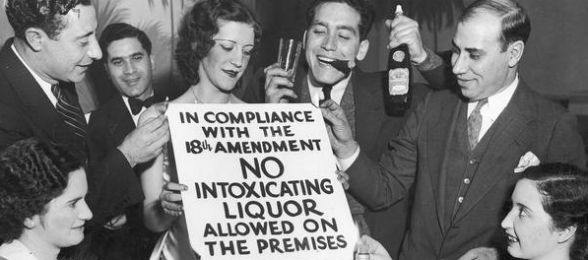
The prohibiting of alcohol manufacture, sale, and use in the United States occurred over a 13-year period from 1920 to 1933. This period became known as the Prohibition Era, and it had a profound impact on society. In fact, the consequences of Prohibition were not what was originally anticipated or hoped for. Although Prohibition went into full swing in 1920, the movement that led up to it was a long time coming. In fact, it was nearly 100 years in the making, beginning with the first national temperance movement, which began with the American Temperance Society in 1826.
- PBS: Roots of Prohibition
- The American Temperance Society
- History of the Movement: Anti-Saloon League
- Bet You Didn’t Know: Prohibition
- The Effects of Prohibition
- Alcohol, Temperance, and Prohibition
The temperance movement was originally started by Presbyterian ministers. Members of the Temperance Society pledged to abstain from distilled beverages; however, this abstaining did not apply to wine or beer. In 1893, the Anti-Saloon League, which would later become the Anti-Saloon League of America, was formed. As the name implies, this league was against saloons and alcohol, and it adopted the motto, “The Saloon Must Go.” This organization worked with churches to push its message, and it also worked to have stronger anti-alcohol laws passed. As the movement grew, states began to pass prohibition laws; however, this was not enough for the Anti-Saloon League, and they eventually began to seek support for national prohibition laws to be passed. Although the 18th Amendment was originally presented in 1913, it took World War I to create the greatest interest in it. This was due to many brewers being German. The 18th Amendment was reintroduced to Congress, which passed it in December 1917. In only 13 months, the bill was ratified, and the country became legally dry on January 16, 1919. In 1920, clarification of what constituted intoxicating liquors was made when the Volstead Act was enacted. This dashed any hopes that wine and beer would be spared from the ban, as the Volstead Act defined intoxicating liquor as anything in excess of 0.5 percent alcohol.
- Events and People of the 1920s: Prohibition
- Encyclopedia of Oklahoma History and Culture: Prohibition
- The Noble Experiment
- Ohio History Central on Prohibition
- Kansas Historical Foundation: Prohibitation
- Prohibition Overview
The hope for an end to crime and poverty and other “evils” associated with alcohol did not happen as anticipated. Almost immediately after the 18th Amendment went into effect, crimes associated with the theft of alcohol began to occur. Other crimes, such as manufacturing alcohol illegally, were already taking place; however, this increased significantly once the country became legally dry. The transporting or smuggling of alcohol was done by people who were known as bootleggers or “rum-runners.” Alcohol, or moonshine, was smuggled across the nation from one state to the next, and it was also smuggled from other places such as Canada or the Caribbean. Although saloons were closed down, speakeasies began to crop up so that there were roughly two to three times as many illegal bars as there had been legal saloons. The amount of crime associated with alcohol quickly began to fill up the jails as everyone from everyday families to organized criminal operations began manufacturing wine and alcohol illegally. Loopholes in the law made it possible for pharmacies to write prescriptions for whiskey in order to treat certain illnesses. As a result, pharmacies grew in some areas, such as New York state.
- Digital History: Prohibition
- During Prohibition, Your Doctor Could Write You A Prescription for Booze
- Bootlegging
- Speakeasies and Bootlegging
- Booteggers, Rum-Runners, and Moonshine: The Business of Prohibition
Prohibition also marked the rise of organized crime, as the illegal manufacture and sale of alcohol became increasingly profitable. Often, it was so lucrative for criminals that they could pay off corruptible law officials so that they would ignore their activities or even cooperate with them. In efforts to combat the rise in crime and enforce the laws on alcohol, the Federal Bureau of Prohibition was created. One of the most recognizable organized crime bosses in history was Al Capone, although he was not the only one. Often fights, between different mob groups would occur; for example, on February 14, 1929, Al Capone murdered members of a rival gang in Chicago. This event became known as the Valentine’s Day Massacre. The crime that the temperance movement had hoped to extinguish was now greater than ever before. As a result of the heightened crime and overall dissatisfaction regarding America’s enforced dry state, the influence and impact of remaining temperance groups began to wane.
- Chicago Historical Society: Al Capone
- Organized Crime: How it Was Changed by Prohibition
- The Effects of Prohibition on Crime During the 1920s “Gangster Era”
- Gangsters During Prohibition
- Understanding Prohibition: A Nobel Experiment
In response to the problem of organized crime, agents such as Elliott Ness with the Federal Bureau of Prohibition came onto the scene. Ness is widely recognized due to his work to bring down Capone in Chicago, which had become the “Crime Capital of the World.” Elliot Ness led a group of agents that became known as the Untouchables. In addition to sending Capone to prison, Ness also aided in cleaning up Cleveland and Cincinnati, which were both also riddled with crime. Prohibition was repealed on December 5, 1933, with the ratification of the 21st Amendment. The repeal came due to a number of factors that included the Great Depression and the loss of revenue from income taxes, as well as the cost of increased crime. The government’s ability to regain liquor taxes as a source of revenue is thought to be the largest of these factors.
- The FBI and the American Gangster
- The Badges Tell the Story
- Prohibition: A Case Study of Progressive Reform
- The End of Prohibition: What Happened and What Have We Learned?
- The Slow Death of Prohibition
- On This Day: Prohibition is Ratified
- Celebrating the Repeal of Prohibition on December 5, 1933 (video)
- Prohibition Definitions and How it Failed
Although it was coined the “Noble Experiment,” Prohibition sent the United States into a state of turmoil. Instead of creating a more prosperous nation, people who worked in the industry lost jobs and other businesses saw sales decline. Most notably, the amount of crime that flooded the country was devastating and far worse than before Prohibition went into effect. Although the intent was a well-intended one, it was widely considered a failed effort.








